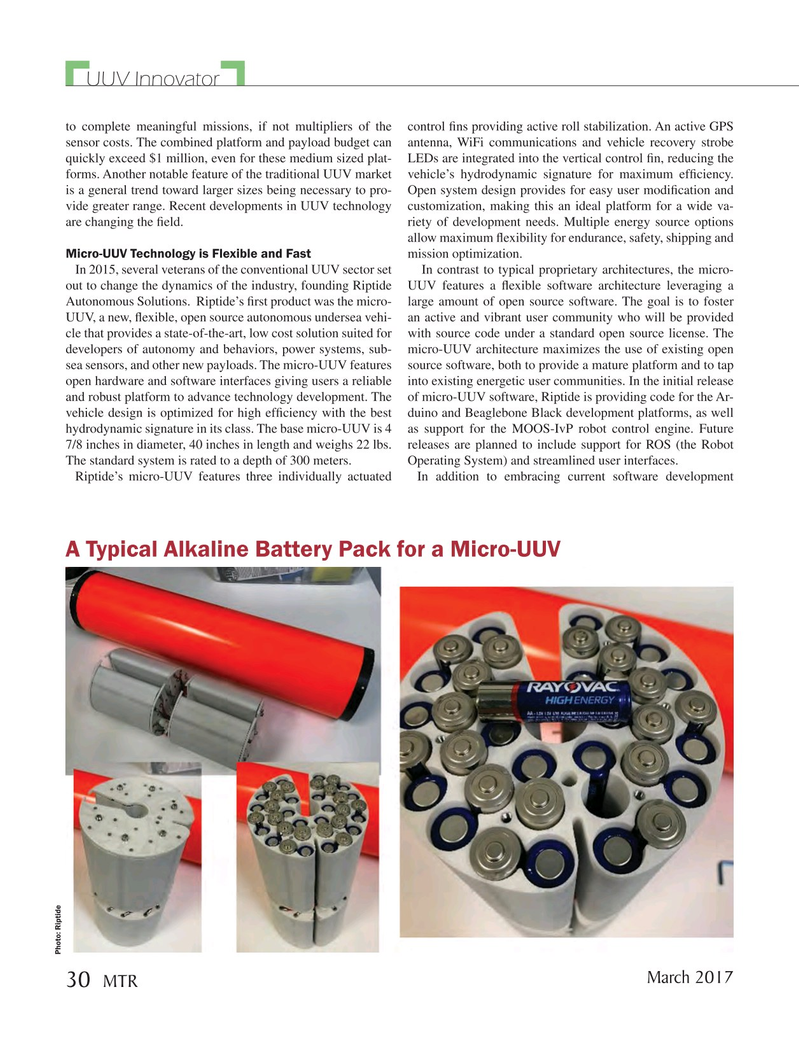
Page 30: of Marine Technology Magazine (March 2017)
Oceanographic Instrumentation: Measurement, Process & Analysis
Read this page in Pdf, Flash or Html5 edition of March 2017 Marine Technology Magazine
UUV Innovator to complete meaningful missions, if not multipliers of the control ? ns providing active roll stabilization. An active GPS sensor costs. The combined platform and payload budget can antenna, WiFi communications and vehicle recovery strobe quickly exceed $1 million, even for these medium sized plat- LEDs are integrated into the vertical control ? n, reducing the forms. Another notable feature of the traditional UUV market vehicle’s hydrodynamic signature for maximum ef? ciency. is a general trend toward larger sizes being necessary to pro- Open system design provides for easy user modi? cation and vide greater range. Recent developments in UUV technology customization, making this an ideal platform for a wide va- are changing the ? eld. riety of development needs. Multiple energy source options allow maximum ? exibility for endurance, safety, shipping and
Micro-UUV Technology is Flexible and Fast mission optimization.
In 2015, several veterans of the conventional UUV sector set In contrast to typical proprietary architectures, the micro- out to change the dynamics of the industry, founding Riptide UUV features a ? exible software architecture leveraging a
Autonomous Solutions. Riptide’s ? rst product was the micro- large amount of open source software. The goal is to foster
UUV, a new, ? exible, open source autonomous undersea vehi- an active and vibrant user community who will be provided cle that provides a state-of-the-art, low cost solution suited for with source code under a standard open source license. The developers of autonomy and behaviors, power systems, sub- micro-UUV architecture maximizes the use of existing open sea sensors, and other new payloads. The micro-UUV features source software, both to provide a mature platform and to tap open hardware and software interfaces giving users a reliable into existing energetic user communities. In the initial release and robust platform to advance technology development. The of micro-UUV software, Riptide is providing code for the Ar- vehicle design is optimized for high ef? ciency with the best duino and Beaglebone Black development platforms, as well hydrodynamic signature in its class. The base micro-UUV is 4 as support for the MOOS-IvP robot control engine. Future 7/8 inches in diameter, 40 inches in length and weighs 22 lbs. releases are planned to include support for ROS (the Robot
The standard system is rated to a depth of 300 meters. Operating System) and streamlined user interfaces.
Riptide’s micro-UUV features three individually actuated In addition to embracing current software development
A Typical Alkaline Battery Pack for a Micro-UUV
Photo: Riptide
March 2017 30 MTR
MTR #2 (18-33).indd 30 MTR #2 (18-33).indd 30 2/28/2017 5:35:56 PM2/28/2017 5:35:56 PM

 29
29

 31
31
